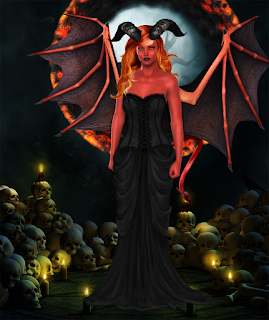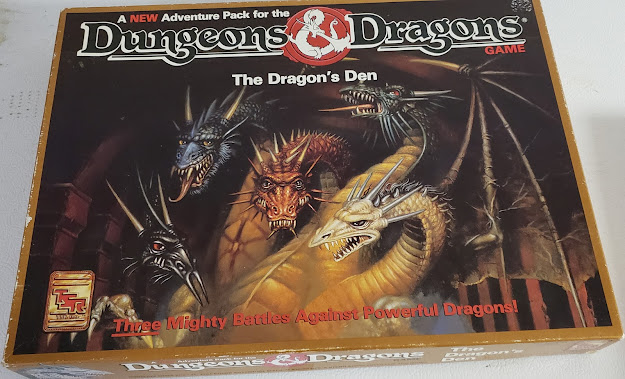But that is not today's discussion. Today I want to discuss Knockers.
Knockers are a subterranean species that frequent old mines. They are common to Cornwall so they could be related to any number of Cornish faeries (and they have a lot of the Fey there) but in reality, they seem closer to the Kobold. Or at least how the kobold has been depicted in German folklore.
Around the time of 2nd Ed Kobolds went from evil little dog men to evil little lizard men. Personally, I rather liked the change. I love the idea of these scrappy little lizards running around. I am also fine with them being evil, or at least very, very self-centered as a species. Their lizard brains only allow for survival in the most brutal ways possible. As such, they worship the things that look like them, only bigger, evil dragons. If your god is evil then you probably are as well. Do I leave room for a potentially "good" kobold? Of course, the world is vast, strange and wonderful, anything is possible.
But as it turns out I have good kobolds covered.
Knockers are good* kobolds.
I say good* because good ≠ nice.
They are happy to work with each other, they get along fine with gnomes and the local pixies. They will even help lost miners find their way out of mines when they are lost. But their reasons are hardly altruistic. They feel that humans are big lumbering idiots and think they belong to the same species as ogres or trolls. They will lead miners out via a series of knocking or raps on stone not because they feel bad for the human but because one lost human brings in many more humans to look for them.
Knockers and kobolds share a history. Once they were the same people. Living in deep subterranean mines looking for veins of precious metals. Their diggings brought them into contact with goblins, dwarves, gnomes, and even orcs. All these encounters ended poorly for the kobolds as they were smaller in size. They grew to despise most other species. As time went on the waters began to return as the last Ice Age began to thaw. When their homelands were taken by the sea, some moved west while others moved east and south. The two peoples became distinct. The kobolds of the south took on the worship of evil gods and dragons. Their lust for gold and power corrupted them into smaller forms and they took on more draconic features. The kobolds of the west became more and more introverted and xenophobic. Their distrust of others never abating but deciding that their best course of action was not to fight but to hide deeper and deeper in the Earth.
The two sub-species of kobold barely resembles the other today, but there are still similarities if one knows how to look.
Knocker (Kobold)
Basic-era Games
Humanoid (Subterranean)
Frequency: Rare
Number Appearing: 2-20 (2-4)
Alignment: Neutral (Neutral Any)
Movement: Basic 90' (30') [9"]
Armor Class: 6 [13]
Hit Dice: 1d6 (3 hp)
Attacks: 1
Damage: 1d4 (weapon)
Special: Hide in shadows 95%
Size: Small
Save: Normal Human
Morale: 7
Treasure Hoard Class: I (XIII)
XP: 7
Knockers are a relative of the kobold. They resemble them in most respects save that these creatures appear to be more "humanoid" than their lizard-like counterparts. Often described as "dog-faced" it is unclear whether that is a reference to their actual canine-like appearance or to their general ugliness.
Knockers speak their own variation of the kobold language, but either sub-species can understand the other given a little time.
Knockers are believed to have interbred with gnomes and goblins in their travels west, and this is used to explain their changed temperaments. Knockers generally get along well enough the gnomes and local fae and even tolerate goblins. Consequently, their greatest enmity is with kobolds and humans.
For the most part, knockers look to be left alone to continue to mine their mines. They will defend their communities if attacked using group tactics. If left alone, they will often leave others alone as well.
One Man's God
Kurtulmak is the god of Kobolds, though in truth he should also be a Demon Lord like Yeenoghu. He is described as being a bit reptilian as well. In keeping with a theme the demon lord (lady) that evil knockers follow is Zsusr.
Knocker
No. Appearing: 2-20
AC: 6
Move: 30ft.
Hit Dice: 1
Special: Hide in Shadow 95%, Pack tactics
XP VALUE: 7
Knockers are a subterranean humanoid people related to the fae. They typically live in old mines and in the dungeons under old castles.
Generation HEX: Some magical schools, particularly AMPA Cornwall in Great Britain, has a group of knockers living below the school. AMPA faculty have yet to decide what needs to be done with them if anything at all.
Ordinary World: Knockers have been known to live in the White and Adirondack Mountain ranges. They are believed to have migrated with English, Welsh, and Cornish immigrants. Here they have interacted with the local populations of Pukwudgie peoples.
Note: Want more information? Dump Stat goes into a Deep Dive of the Kobold across many editions.






















































